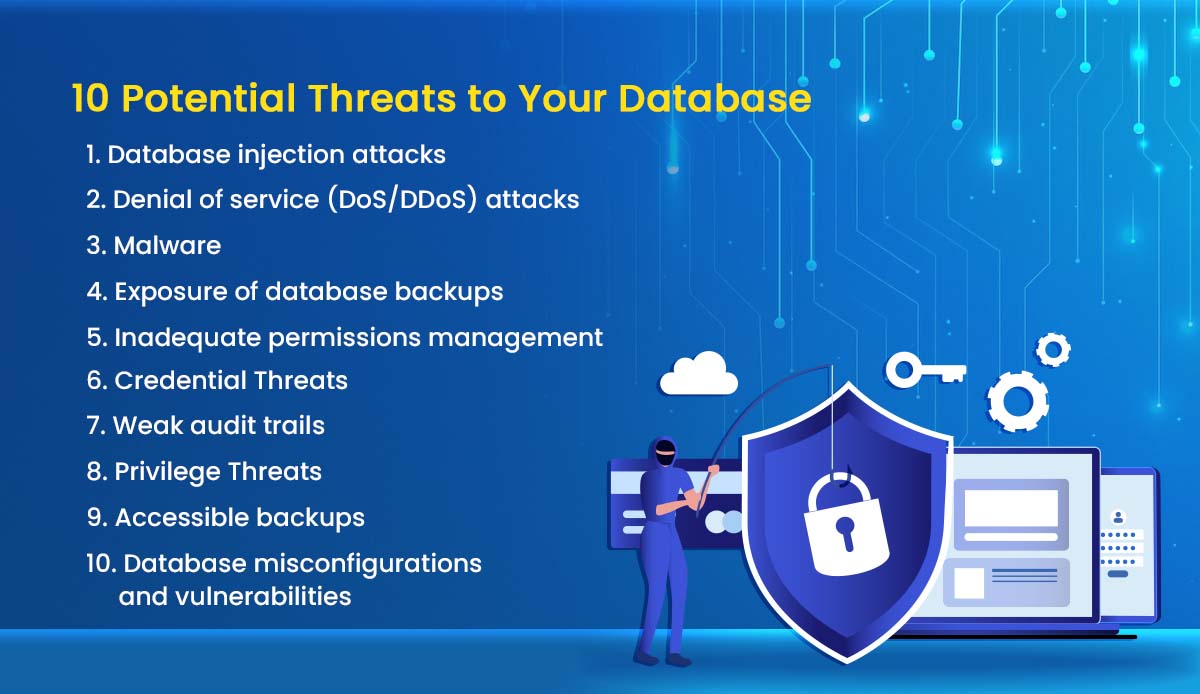Defending Against Top 10 Database Security Threats

Data is a crucial asset for your business. Every day, businesses collect a large amount of data from their customers and daily operations. The information kept in databases is then used to handle and automate various tasks both inside and outside of businesses.
Data protection is essential to business security because of its significance.
We’ll explore more about potential threats to database security and steps you can take to safeguard your database in this blog:
1. Database injection attacks
Database injection attacks typically take the form of SQL injection attacks.
It usually targets RDBMSs that use SQL as well as relational database servers. NoSQL databases are resistant to these attacks, but they are vulnerable to NoSQL Injection attacks, which are less frequent but just as dangerous.
Both of these attacks work by getting comments on the database engine to expose data and its structures by getting around data entry controls of web applications. Usually, in extreme cases, a successful injection attack will typically give the attacker unrestricted access to the database’s core.
2. Denial of service (DoS/DDoS) attacks
This attack usually occurs when the cybercriminal overwhelms the target service. This is typically the database server in this situation, using a large number of fictitious requests. Consequently, the server cannot carry genuine requests from actual users – it will either crash or become unstable.
In a DDoS, a sizable number of computers typically produce fake traffic. It is a botnet that the attacker controls that generate a lot of traffic that is challenging to stop, especially if you don’t have a highly defensive architecture. These significant attacks can be scaled and dynamically addressed by a cloud-based DDoS protection service.
3. Malware
Malware is software designed to exploit any flaws that could harm a database. They could access the network of the database from any endpoint device.
Because of their high value and sensitivity, database servers are the type of endpoint where malware protection is essential.
4. Exposure of database backups
Making backups of exclusive databases within a predetermined time frame is a good practice. However, many database backup files are frequently not secured against intrusion. As a result, database backup leaks are a common cause of security breaches.
Here are some helpful tips to avoid this:
- Encrypt backups as well as databases
To protect the databases’ production and backup copies, store data in an encrypted format.
- Audit the backups and database
By doing this, you can find out who has been attempting to access this private information.

5. Inadequate permissions management
Database servers are frequently set up with their default security settings in an organisation and are frequently never changed. As a result, attackers who are aware of the default permissions and are skilled at exploiting them can access databases.
Similar to the misuse of legitimate permissions, users with access to databases may do so without authorization. For example, they might reveal private information.
Another security risk that is frequently disregarded is that of inactive accounts. These accounts may be used by malicious people to gain unauthorized access to the database because they are aware they exist.
6. Credential Threats
In a similar context, a weak password and inadequate authentication also make it obvious for the attacker to pass for authorized database users.
These particular attack methods include social engineering techniques like phishing and brute force attacks.
7. Weak audit trails
Generally speaking, businesses should log and register each of their database events and employ tools for automatic auditing. The ability to execute this should also exist, or there may be a serious risk on several levels. Because of this, you need to use database auditing solutions that don’t burden databases further.
8. Database misconfigurations and vulnerabilities
Databases may become unprotected as a result of incorrect configuration. There might be default configuration settings and accounts on some systems.
Hackers are skilled IT specialists in their own right. They are therefore well-equipped on attacking your company by taking advantage of any database configuration errors and vulnerabilities. Support for database management is essential because of this.
Some of the countermeasures that you could enforce:
- Databases shouldn’t have any default accounts.
- Your in-house IT staff should be highly experienced and qualified in database administration and management.
9. Privilege Threats
Additionally, there could be instances where a user unintentionally abuses their access privileges or where an administrator grants the user exclusive access due to carelessness or oversight.
Therefore, privilege account abuse happens when the rights associated with the user account are used fraudulently or appropriately. It may be done purposefully, unintentionally, or through willful policy ignorance.
Privilege escalation might occur when the attackers take advantage of the data management software vulnerabilities. Low-level access privileges will be upgraded to high-level access privileges. This usually entails more work and expertise than straightforward privilege abuse.
10. Accessible backups
Although your database may be protected with multiple layers of security, unauthorized users may still access backups of these databases if they make copies of the originals. Then, these malicious individuals might mount them on their servers in order to obtain all the sensitive data that these might contain.
Strategies to Protect Databases
Now that you are aware of the most common database security threats, here are some helpful suggestions to protect your database:
- Train the employees with best practices and risk mitigation techniques.
- Control access rights for users, reduce their privileges, and delete inactive users
- Put a stop to any malicious web requests.
- Monitor all database access activity and usage patterns in real-time
- Archive your external data
- Encrypt databases
- Conceal database fields to hide any sensitive information
Your Turn

So, there you have it. These are the ten major dangers to database security. To reduce any security risks from a data breach, strengthen the security of your database.
With ESDS, you get the benefit of managing the database you host on our servers as well as our database administration and support service for your database management in our certified state-of-the-art data center. We offer a range of security services, including SOC services and secure access services such as eNlight WAF, an intelligent, cloud-hosted web application firewall that allows users easier segregation of incoming and outgoing web traffic. Protect your databases with confidence and focus on what matters most – your business success.
Take proactive measures to fortify your database security today and safeguard your valuable data from potential threats. Don’t wait any longer!
- 6 Ways AI Reinvents the Security Landscape - January 9, 2024
- Top 6 Current Cybersecurity Trends For 2024 - January 9, 2024
- What Have We Learned from The Recent Cybersecurity Incidents? - January 3, 2024
